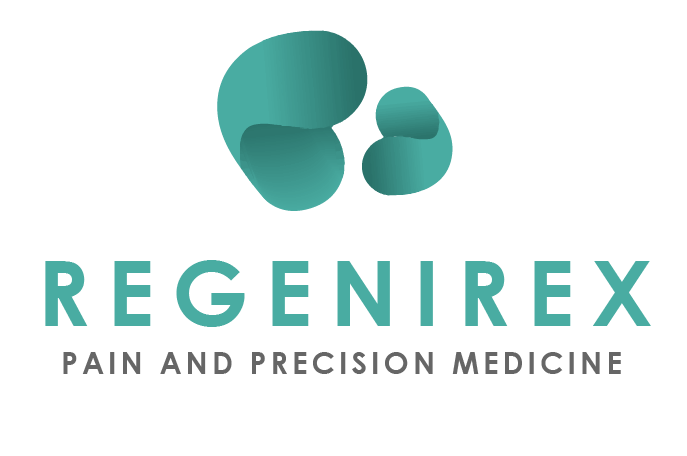At Regenirex, our top priority is helping you achieve optimal health and well-being. If you’re struggling with chronic pain, we understand the significant impact it can have on every aspect of your life. That’s why our expert team is committed to providing you with effective and natural relief.
During your initial consultation, we’ll evaluate your symptoms and work with you to develop a personalized treatment plan tailored to your unique needs. We always strive to avoid using opioids, as we believe they are not a suitable solution for managing chronic pain.
Trust us to provide you with safe, effective pain management solutions that help you reclaim your quality of life.
Treatments We Offer
At Regenirex, we offer a range of treatments to help manage chronic pain and improve your overall quality of life. Our treatment options include solutions for back pain, joint pain, abdominal pain, regenerative medicine treatments, and hormone replacement therapy. We believe in providing personalized care and avoiding opioid use whenever possible to help you find natural relief.
The following is a partial list of the treatment options we provide. If you are in pain but don’t see a specific treatment listed, don’t hesitate to call for a consultation. If we can’t treat you, we can most likely get you to someone who can.


Read on to learn more about our treatment options and how we can help you manage your chronic pain effectively.
- Epidural Steroid Injections (all epidurals and most of our procedures are performed with x-ray guidance)
- Facet Injections
- Radio-frequency Ablation
- Sympathetic Nerve Blocks
- Ilioinguinal Nerve Blocks
- Trigger Point Injections
- Vertebroplasty & Kyphoplasty
- Sacroiliac Joint Injections
- Sacroiliac Joint minimally invasive fusion Neurostimulation (Learn more here and here)
- Intrathecal Drug Delivery
- DRG Stimulation
- Medication Management
- Regenerative Medicine Techniques, including
- Platelet Rich Plasma Injections & Stem Cell
- Injections (performed using both bone marrow-derived stem cells & mesenchymal stem cells derived from abdominal fat)
- Hormone optimization therapy (biote certified providers but also have options other than pellets)
- Minimally Invasive Lumbar Decompression procedure
- Basivertebral Nerve Ablation for Vertebrogenic Low Back Pain
- Minimally Invasive Posterior Spinal Fusion for the treatment of degenerative disc disease.
- Temporary Peripheral Neurostimulator
Back & Spinal Pain Treatments
Back and spinal pain can be a challenging and debilitating condition that affects millions of people worldwide. Fortunately, there are many different treatments available that can help to alleviate back pain and improve quality of life. The specific treatment that is best for each individual will depend on factors like the underlying cause of the pain, the severity of the pain, and the individual’s overall health and medical history.
An epidural steroid injection is a procedure that involves injecting steroid medication around the spinal cord to reduce inflammation and relieve pain in the lower back or neck. X-ray guidance is used to ensure that the injection is placed in the correct location, avoiding any sensitive structures in the area. The procedure can be helpful for people with conditions like spinal stenosis, herniated discs or sciatica.
Medial branch blocks are diagnostic nerve blocks to help determine the source of your pain. Numbing medication is injected into nerves located in the small joints between the vertebrae of the spine called the facet joints. These nerves get pinched by arthritis in your spine. A positive result from a medial branch block would be complete pain relief immediately following the injection. Most people only get a couple of hours of relief but some people get months or years of relief from the medial branch blocks. The overall goal is to determine the nerves that are the source of your pain so that we can then use radiofrequency ablation to damage those nerves which provides longer lasting relief.
Radio-frequency ablation is a procedure that uses heat generated from radio waves to damage specific nerves and reduce pain signals to the brain. The procedure is typically used to treat chronic pain in areas like the neck, back, or joints. During the procedure, a needle with an electrode is inserted near the targeted nerves, and radio waves are used to generate heat that damages the nerve fibers. This can provide pain relief that can last for several months or longer.
A sympathetic nerve block involves injecting medication into the sympathetic nerves located in the neck, chest, or back. The goal of the injection is to reduce pain and other symptoms caused by conditions like reflex sympathetic dystrophy (RSD) or complex regional pain syndrome (CRPS). The medication used in the injection typically includes a local anesthetic and a steroid medication. The block can provide pain relief that can last for several months or longer.
Trigger point injections involve injecting a small amount of medication directly into the affected muscle to relieve pain and discomfort caused by muscle tension or spasms.
Vertebroplasty & Kyphoplasty are used to treat compression fractures in your vertebrae. In vertebroplasty, a type of medical-grade cement is injected into the fractured vertebra to stabilize it. In kyphoplasty, a small balloon is first inserted into the fractured vertebra to create space, and then the cement is injected into the space to stabilize the vertebra.
Neurostimulation involves essentially an epidural injection and then tiny wires are inserted and placed near the spinal cord. These wires then send electrical impulses that can help to block pain signals from reaching the brain. This can be helpful for people with chronic pain conditions that have not responded well to other treatments. Watch our videos to learn more.
Dorsal root ganglion or DRG stimulation is similar to neurostimulation but involves placing the electrodes near the dorsal root ganglion, a cluster of nerve cells near the spinal cord. This can be helpful for people with complex regional pain syndrome of the distal extremities.
Intrathecal drug delivery involves placing a small pump with an epidural catheter attached, under the skin of the abdomen. The catheter is placed into the fluid surrounding the spinal cord. This then delivers medication at a constant rate right of the source of the pain, the nerves. This is often a last resort for people who have failed all other treatments.
Medication management refers to the use of medications to control your pain. While our goal is to treat chronic pain without medication, we understand in some circumstances procedures are not an option and we can safely provide and monitor the use of different types of medications, including prescription pain medication and provide guidance on over the counter options available.
Dr. McKeag has started doing the MILD procedure again. For years he offered it in North Platte but when he began his pain management fellowship he quit offering this service. He is excited to be able to offer this procedure again to his patients. When epidurals are no longer effective at treating pain related to spinal stenosis, this procedure is an option. It has a safety profile similar to an epidural and can provide longer lasting relief. This procedure was designed to help people be able to stand longer and walk farther without pain. If you have difficulty standing up straight without pain or walking without leaning on something like a walker or grocery cart, this procedure may be right for you. This procedure begins as an epidural and then some of the ligament that is causing the stenosis is removed.
In March 2023 Dr. McKeag had training for the Intracept procedure. This procedure is for people with vertebrogenic back pain, where the source of your pain is the bones in your back. Similar to a vertebroplasty, a needle is inserted into the vertebra identified by MRI to be the source of your pain. Then using radiofrequency that nerve is heated up thereby destroying the pain signals.
In February 2023 Dr. McKeag underwent training on a minimally invasive posterior spinal fusion using the Minuteman device. This is an option for people who don’t want or can’t have major back surgery when other less invasive procedures are no longer effective (for example epidurals)
Anxious about the possibility of a permanent device implanted near your spine? Never fear, we have another option where you temporarily wear a device for 60 days and have it removed. Patient’s have seen a year of relief or more with this and there is no concern with a permanent device. Dr. McKeag trained for this device this spring and has a handful of patients scheduled to get try this device in April. It can treat back pain but also specific joint and nerve pains.
Column 2

Back & Spinal Pain Treatments
Back and spinal pain can be a challenging and debilitating condition that affects millions of people worldwide. Fortunately, there are many different treatments available that can help to alleviate back pain and improve quality of life. The specific treatment that is best for each individual will depend on factors like the underlying cause of the pain, the severity of the pain, and the individual’s overall health and medical history.
An epidural steroid injection is a procedure that involves injecting steroid medication around the spinal cord to reduce inflammation and relieve pain in the lower back or neck. X-ray guidance is used to ensure that the injection is placed in the correct location, avoiding any sensitive structures in the area. The procedure can be helpful for people with conditions like spinal stenosis, herniated discs or sciatica.
Medial branch blocks are diagnostic nerve blocks to help determine the source of your pain. Numbing medication is injected into nerves located in the small joints between the vertebrae of the spine called the facet joints. These nerves get pinched by arthritis in your spine. A positive result from a medial branch block would be complete pain relief immediately following the injection. Most people only get a couple of hours of relief but some people get months or years of relief from the medial branch blocks. The overall goal is to determine the nerves that are the source of your pain so that we can then use radiofrequency ablation to damage those nerves which provides longer lasting relief.
Radio-frequency ablation is a procedure that uses heat generated from radio waves to damage specific nerves and reduce pain signals to the brain. The procedure is typically used to treat chronic pain in areas like the neck, back, or joints. During the procedure, a needle with an electrode is inserted near the targeted nerves, and radio waves are used to generate heat that damages the nerve fibers. This can provide pain relief that can last for several months or longer.
A sympathetic nerve block involves injecting medication into the sympathetic nerves located in the neck, chest, or back. The goal of the injection is to reduce pain and other symptoms caused by conditions like reflex sympathetic dystrophy (RSD) or complex regional pain syndrome (CRPS). The medication used in the injection typically includes a local anesthetic and a steroid medication. The block can provide pain relief that can last for several months or longer.
Trigger point injections involve injecting a small amount of medication directly into the affected muscle to relieve pain and discomfort caused by muscle tension or spasms.
Vertebroplasty & Kyphoplasty are used to treat compression fractures in your vertebrae. In vertebroplasty, a type of medical-grade cement is injected into the fractured vertebra to stabilize it. In kyphoplasty, a small balloon is first inserted into the fractured vertebra to create space, and then the cement is injected into the space to stabilize the vertebra.
Neurostimulation involves essentially an epidural injection and then tiny wires are inserted and placed near the spinal cord. These wires then send electrical impulses that can help to block pain signals from reaching the brain. This can be helpful for people with chronic pain conditions that have not responded well to other treatments. Watch our videos to learn more.
Dorsal root ganglion or DRG stimulation is similar to neurostimulation but involves placing the electrodes near the dorsal root ganglion, a cluster of nerve cells near the spinal cord. This can be helpful for people with complex regional pain syndrome of the distal extremities.
Intrathecal drug delivery involves placing a small pump with an epidural catheter attached, under the skin of the abdomen. The catheter is placed into the fluid surrounding the spinal cord. This then delivers medication at a constant rate right of the source of the pain, the nerves. This is often a last resort for people who have failed all other treatments.
Medication management refers to the use of medications to control your pain. While our goal is to treat chronic pain without medication, we understand in some circumstances procedures are not an option and we can safely provide and monitor the use of different types of medications, including prescription pain medication and provide guidance on over the counter options available.
Dr. McKeag has started doing the MILD procedure again. For years he offered it in North Platte but when he began his pain management fellowship he quit offering this service. He is excited to be able to offer this procedure again to his patients. When epidurals are no longer effective at treating pain related to spinal stenosis, this procedure is an option. It has a safety profile similar to an epidural and can provide longer lasting relief. This procedure was designed to help people be able to stand longer and walk farther without pain. If you have difficulty standing up straight without pain or walking without leaning on something like a walker or grocery cart, this procedure may be right for you. This procedure begins as an epidural and then some of the ligament that is causing the stenosis is removed.
In March 2023 Dr. McKeag had training for the Intracept procedure. This procedure is for people with vertebrogenic back pain, where the source of your pain is the bones in your back. Similar to a vertebroplasty, a needle is inserted into the vertebra identified by MRI to be the source of your pain. Then using radiofrequency that nerve is heated up thereby destroying the pain signals.
In February 2023 Dr. McKeag underwent training on a minimally invasive posterior spinal fusion using the Minuteman device. This is an option for people who don’t want or can’t have major back surgery when other less invasive procedures are no longer effective (for example epidurals)
Anxious about the possibility of a permanent device implanted near your spine? Never fear, we have another option where you temporarily wear a device for 60 days and have it removed. Patient’s have seen a year of relief or more with this and there is no concern with a permanent device. Dr. McKeag trained for this device this spring and has a handful of patients scheduled to get try this device in April. It can treat back pain but also specific joint and nerve pains.
Column 2
Joint Pain Treatments
Joint pain can be a common and frustrating condition that affects many people, particularly as they age. One treatment option for joint pain is sacroiliac joint injections, which involve injecting medication directly into the sacroiliac joint to reduce inflammation and alleviate pain. This procedure can be helpful for people with conditions like arthritis or injury-related joint pain.
Joint Pain Treatments
Joint pain can be a common and frustrating condition that affects many people, particularly as they age. One treatment option for joint pain is sacroiliac joint injections, which involve injecting medication directly into the sacroiliac joint to reduce inflammation and alleviate pain. This procedure can be helpful for people with conditions like arthritis or injury-related joint pain.
Column 2

Abdominal Pain Treatments
Abdominal pain can be a common and uncomfortable condition that can have many different underlying causes, including nerve-related issues. One treatment option for abdominal pain is ilioinguinal nerve blocks, which involve injecting medication near the ilioinguinal nerve to reduce inflammation and alleviate pain. This procedure can be helpful for people with conditions like chronic abdominal pain, nerve-related pain, or pain related to surgical procedures.
Column 2
Abdominal Pain Treatments
Abdominal pain can be a common and uncomfortable condition that can have many different underlying causes, including nerve-related issues. One treatment option for abdominal pain is ilioinguinal nerve blocks, which involve injecting medication near the ilioinguinal nerve to reduce inflammation and alleviate pain. This procedure can be helpful for people with conditions like chronic abdominal pain, nerve-related pain, or pain related to surgical procedures.
Column 2

Regenerative Medicine Techniques
Regenerative medicine treatments are a relatively new and exciting area of medicine that involves using the body’s own cells and tissues to promote healing and repair damaged tissue. Two common regenerative medicine treatments are platelet-rich plasma injections and stem cell injections. These treatments have shown promise in treating a range of conditions, including musculoskeletal injuries and degenerative conditions.
Platelet-rich plasma injections involve taking a sample of the patient’s blood, separating out the platelets, and injecting them into the injured or damaged area.
Stem cell injections involve using either bone marrow-derived stem cells or mesenchymal stem cells derived from abdominal fat to help promote tissue repair and regeneration.
Column 2

Regenerative Medicine Techniques
Regenerative medicine treatments are a relatively new and exciting area of medicine that involves using the body’s own cells and tissues to promote healing and repair damaged tissue. Two common regenerative medicine treatments are platelet-rich plasma injections and stem cell injections. These treatments have shown promise in treating a range of conditions, including musculoskeletal injuries and degenerative conditions.
Platelet-rich plasma injections involve taking a sample of the patient’s blood, separating out the platelets, and injecting them into the injured or damaged area.
Stem cell injections involve using either bone marrow-derived stem cells or mesenchymal stem cells derived from abdominal fat to help promote tissue repair and regeneration.
Hormone Optimization Therapy
Hormone therapy (HT) can be an effective treatment for symptoms related to hormonal imbalances or deficiencies, such as perimenopause, menopause, or low testosterone and andropause (male menopause). As a Biote Certified Provider, we have undergone specialized training in administering bioidentical hormone therapy.
Bioidentical hormones are designed to be structurally identical to the hormones naturally produced by the body, which may reduce the risk of side effects compared to traditional hormone replacement therapy. We can help assess whether hormone optimization therapy is right for you, and develop a treatment plan tailored to your specific needs and budget.
Learn more about biote
Column 2
Hormone Optimization Therapy
Hormone therapy (HT) can be an effective treatment for symptoms related to hormonal imbalances or deficiencies, such as perimenopause, menopause, or low testosterone and andropause (male menopause). As a Biote Certified Provider, we have undergone specialized training in administering bioidentical hormone therapy.
Bioidentical hormones are designed to be structurally identical to the hormones naturally produced by the body, which may reduce the risk of side effects compared to traditional hormone replacement therapy. We can help assess whether hormone optimization therapy is right for you, and develop a treatment plan tailored to your specific needs and budget.
Learn more about biote
Column 2





